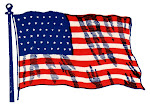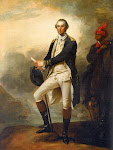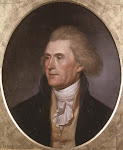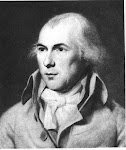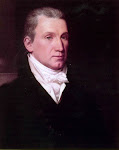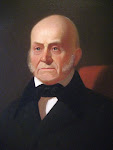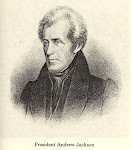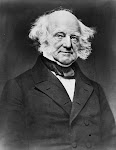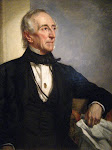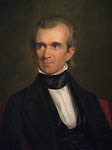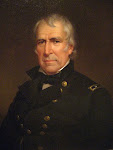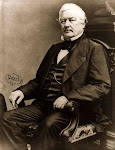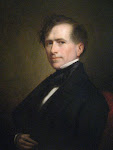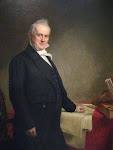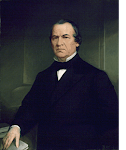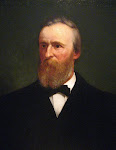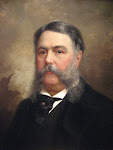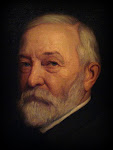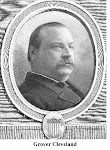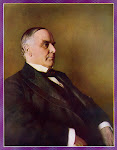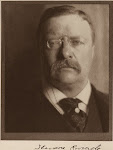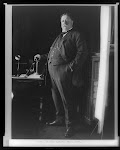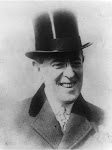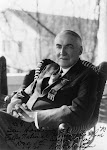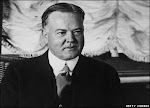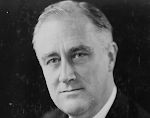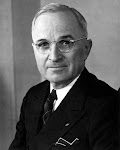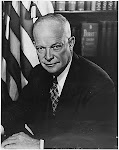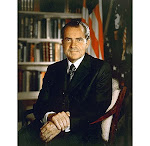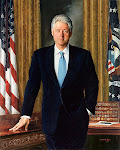THE WHITE HOUSE
1600 PENNSYLVANIA AVENUE NW
WASHINGTON. DC
All but one of the forty-three Presidents of the United States lived in the White House, the official residence and principal workplace of the Presidents of the United States. The exception was the first, George Washington. It was built between 1792 and 1800. The structure was not ready for occupancy until later in John Adams only term, and even then not all the rooms were finished. The Executive Mansion was not then called the White House. It was originally referred to as the "President's Palace," "Presidential Mansion," or President's House." Allegedly, the building received its present name after the structure was rebuilt after it was set ablaze by the British in 1814 during the War of 1812. The exterior was painted white to mask the burn damage it had suffered.
Throughout the years, the building has had additions and modifications ordered by various Presidents. Today the six story structure includes the Executive Residence, The West Wing, which contains the Oval Office and the Cabinet Room, and the East Wing, the location of the office of the First Lady and White House Social Secretary. Nine proposals were made for the construction of the Executive Mansion. The winning entry was that of James Hoban of Charleston, South Carolina. Hoban's design was influenced by portions of Leister House, in Dublin, Ireland, later the seat of the Irish parliament.
MOUNT VERNON
FAIRFAX COUNTY, VIRGINIA
Located near Alexandria, Virginia, Mount Vernon was the plantation home of George Washington, the first President of the United States. When owned by George's father Augustine Washington, the estate was known as Little Hunting Creek Plantation. When George's older half-brother, Lawrence Washington inherited the property, he renamed Mount Vernon to honor his commanding officer in the British Navy, Vice Admiral Edward Vernon. Upon Lawrence's death without issue, his will provided that his widow Anne should own a life estate at Mount Vernon, with the remainder going to George. When Anne died, the entire estate passed to George. The remains of George and his wife Martha are entombed on the grounds at Mount Vernon. The property consists of 500 acres. The house was built in stages - the northern portion was expanded several times during its history.
PEACEFIELD
QUINCY, MASSACHUSETTS
Also known as the Old House, Peacefield was the home and farm owned by the second President of the United States, John Adams, as well as by other members of the Adams family. The oldest portion of the house was built in 1731 by Leonard Vassal. It was acquired by John And Abigail Adams in 1787 after its loyalist owners abandoned it during the Revolutionary War. While John was serving as Vice President and President, Abigail ran the house and farm. Claiming the structure felt like "a wren's nest," had in greatly expanded, with additions built in the Georgian style.
MONTICELLO
CHARLOTTESVILLE, VIRGINIA
Monticello is the estate of the third President of the United States, Thomas Jefferson. He designed and redesigned the neoclassical house, based on principles established by Italian Renaissance architect Andrea Palladio. Jefferson had it built and rebuilt over a period of forty years. He created the botanical gardens of the property as a showplace, a source of food, and an experimental laboratory of flowers and plants from all over the world. The plantation consisted of 5,000 acres. When Jefferson died in 1826, his daughter Martha Jefferson Randolph inherited Monticello. She was forced to sell the property to pay off debts and eventually came to be owned by the Uriah P. Levy family. In 1879, his nephew Jefferson Monroe Levy had Monticello repaired, restored and preserved. The house is now operated as a museum by the Thomas Jefferson Foundation.
MONTPELIER
ORANGE, VIRGINIA
In 1723, Ambrose Madison, the grandfather of the fourth President of the United States, James Madison, and his brother-in-law Thomas Chew, were deeded 4,675 acres in the newly opened Piedmont territory of Virginia. Ambrose called his plantation complex,
Mount Pleasant, and when it became known as Montpelier is uncertain. Some believe that it was named for Montpellier, the Medieval French term for "Mount of the Pilgrim. Montpellier, France is a spa resort known for its pure healthy air, as is Madison's Montpelier. The property remained in the Madison family for 120 years, until James' wife Dolley had to sell it to pay off debts. It was acquired by members of the du Pont family in 1901. In 1984, Marion du Pont Scott transferred the estate to the National Trust for Historic Preservation. a $25 million restoration program of the house and property was begun in 2002 and completed in 2008.
ASH LAWN - HIGHLAND
CHARLOTTESVILLE, VIRGINIA
Highland farm was owned by the fifth President of the United States and his wife Elizabeth Kortright Monroe. Located in Ablemarle County, Virginia, it was their residence from 1799 to 1823. After their death, the name of the farm was changed from "Highland" to "Ash Lawn. Today, both names are used for the 535-acre working farm, which was bequeathed to the College of William and Mary in 1974 by Jay Winston Johns to operate as a "historic shrine for the education of the general public.
BIRTHPLACE OF JOHN QUINCY ADAMS


141 FRANKLIN STREET, QUINCY, MASSACHUSETTS
John Quincy Adams, the sixth President of the United States, was born in the saltbox house used as a home an office of his father John Adams, who was born in a similar saltbox only 75 feet away from the one shown in the picture. JQA inherited Peacefield from his father and the Quincy estate on the seashore from his maternal grandparents.
THE HERMITAGE
4580 RACHEL'S LANE, NASHVILLE, TENNESSEE
Despite being the first President of the United States not from the aristocracy, Andrew Jackson was able to transform a modest country farm into a 1,000-acre plantation that he named The Hermitage. The mansion was constructed during the period 1819 to 1821. The original section was brick Federal style Ante-bellum house. In 1831 a major remodeling added flanking one story wings and a two-story portico with ten Doric columns. When fire heavily damaged the house in 1834, the entrance facade was built with the appearance of a Greek temple, complete with six two-story columns with modified Corinthian capitals arranged across the front porch. Since the home was opened as a museum in 1889, approximately 16 million visitors have toured The Hermitage.
OLD POST ROAD, KINDERHOOK, NEW YORK
Named for the numerous Linden trees on the estate, Lindenwald was the home of Martin Van Buren, the eighth President of the United States. The original house on the property was built in 1797. Through neglect, the house and property had seriously deteriorated by the time Van Buren paid $14,000 for it in 1839. He set about making his Hudson Valley estate into a working farm. By 1845, he had more than 220 acres in crops, as well as formal flower gardens. Van Buren made elaborate modifications of the large two-story brick house. He removed the central stairway from the entrance hall to create two large rooms on each level. A four-story brick tower, a central gable, attic dormers and a porch were added. Then the house was painted yellow. The Martin Van Buren National Historic Site consists of 22 acres of Van Buren's holdings, plus the mansion.
GROUSELAND
3 WEST SCOTT STREET, VINCENNES, INDIANA
William Henry Harrison, ninth President of the United States built a substantial brick home in 1804, which he named Grouseland, because his estate abounded with these game birds. He lived there , while serving as governor of Indiana Territory, until he left to take command of American forces in the old Northwest during the War of 1812. The blended plantation, mansion and fortress is located along the Wabash River. The building contains 26 rooms and 13 fireplaces. Because of threats of Indian raids, the exterior walls are 18 inches thick with portholes for sharpshooters. Grouseland has been designated a National Historic Landmark and is open to the public. With the outbreak of the War of 1812, Harrison moved to his family to a farm his wife inherited at North Bend, Ohio.
SHERWOOD FOREST

14501 JOHN TYLER HIGHWAY, CHARLES CITY, VIRGINIA
Sherwood Forest Plantation, a Georgian clapboard, was the home of the tenth President of the United States, John Tyler, from 1842 until his death in 1862. While open to the public, the 1,200-acre plantation has been the continuous residence of the Tyler family since he purchased it. Tyler expanded the original 1780 frame house into one of the longest private residences in Virginia - 300 feet long but only one room deep. Originally called Walnut Grove, Tyler renamed it when Henry Clay accused the President of being an outlaw retiring to his Sherwood Forest - a reference to Robin Hood.
ONLY SURVIVING HOME OF JAMES KNOX POLK
301 WEST 7TH STREET, COLUMBIA, TENNESSEE
This Federal style home was built by the father of the eleventh President of the United States James Knox Polk about 1816. Except for the White House it is the only surviving residence of Polk. It can be visited by the public. Today it hosts over 1000 objects that once belonged to the President and Mrs. Polk, including furniture, paintings and White House china. The President's final residence - a mansion in downtown Nashville - was torn down in 1901.
CYPRESS GROVE
NEAR NATCHEZ, MISSISSIPPI
As a career military man, Zachary Taylor, the twelfth president of the United States, had many residences. Born in Virginia as an infant he was taken to Kentucky. He spent the first twenty-three years of his life on his father's Springfield farm in Louisville, Kentucky. The first home he owned was in Baton, Rouge, Louisiana, bought in 1840. The next year he purchased a 2000-acre plantation on the Mississippi River just above of Natchez.
MILLARD FILLMORE'S CASTLE
NIAGARA SQUARE AT DELAWARE AVENUE, BUFFALO, NEW YORK
In 1823, Millard Fillmore, who would become the thirteenth President of the United States, opened a law office in East Aurora, New York. With the help of friends he built a modest house on Franklin Street (since moved to 24 Shearer Avenue, where it is owned and maintained by the Aurora Historical Society). Besides the White House it is the only surviving home of the President. After his presidency, widower Fillmore married a wealthy, childless widow. They purchased the long-fronted stately Tudor Gothic mansion depicted in the post card. After Fillmore's death, his sons merged the mansion with another to become the Hotel Fillmore, later to be called the Castle Inn. It was demolished to make way for the Statler Towers Hotel in 2002.
PIERCE HOMESTEAD
HILLSBOROUGH, NEW HAMPSHIRE
Franklin Pierce, the 14th President of the United States spent half his life in the mansion built in 1804 by General Benjamin Pierce, hero of the Revolutionary War. The Homestead is operated by the Hillsborough Historical Society. The Greek Revival styled Pierce Manse located in Concord, New Hampshire is the only home ever owed and lived in by President Pierce. It was saved from leveling by being moved from its original site on Montgomery Street to 14 Horseshoe Pond Road in 1967. Both houses are open to tours by appointment at certain times of the year.
WHEATLAND
1120 MARIETTA AVENUE, LANCASTER, PENNSYLVANIA
James Buchanan, 15th President of the United States, was born in a log cabin, which is located on the campus of Mercersburg Academy in Mercersburg, Pennsylvania. The site is open to the public. He resided in various Inns in Lancaster, before moving into a house at 42 king Street. In 1948, He purchased a large Federal style house and 22 acres of land near Lancaster in 1848. Wheatland consists of a two and one half central section flanked by three-story wings. There are 17 rooms in all. A Doric columned porch sits in front of the main section of the house. From a long veranda in the rear, Buchanan could enjoy a vast expanse of growing wheat. Designated a National Historic Landmark, the property can be toured.
LINCOLN'S HOME
EIGHTH AND JACKSON STREET, SPRINGFIELD, ILLINOIS
Abraham Lincoln's birthplace in Kentucky is a National Historic Site. An early 19th century lone-room log cabin symbolizes the one in which Lincoln was born. The first and only home owned by the 16th President of the United States is a National Historic Site. The two-story Springfield house contains twelve rooms. When Abraham was elected President, he and his family set out for Washington, never to return to their home. President Lincoln was assassinated in 1865. His wife, Mary, returned to Springfield, but refused to live in the house. Their only surviving son, Robert Todd Lincoln donated the family home to the State of Illinois on the condition that no fee would be charged to visitors.
OFF MAIN STREET, GREENVILLE, TENNESSEE
Although Andrew Johnson, the 17th President of the United States spent most of his life in Tennessee, he was born in Raleigh, North Carolina. A replica of his log cabin birthplace was constructed in Greenville in 1999. The Andrew Johnson National Historic Site also preserves his two homes, tailor shop, and grave site. The house depicted was the home of Johnson and his family from 1851 until his death in 1875. The two-story brick structure contains 10 rooms. It was seriously damaged during the Civil War and required extensive repairs and refurbishments by Johnson after his presidency.
GIFT TO A HERO
500 BOUTHILLIER STREET, GALENA, ILLINOIS
U.S. Grant, the 18th President of the United States was born in a log cabin near Cincinnati, Ohio. Ulysses S. and Julia Grant had several residences throughout their marriage. As a soldier, an unsuccessful farmer and businessman, Grant at various times lived in Missouri, Michigan, California Ohio, and Illinois. In 1860, he moved his family to Galena, Illinois, where his father and brother had a tannery and leather store. He and Julia rented a modest brick home for about $100 a year. When Grant returned to Galena from the Civil War, the citizens gifted their hero with a handsome furnished Italianate style two-story brick house, which he and his family lived in continuously 1865 until his election as President in 1868. The National Historic Site is now owned by the State of Illinois and is open to the public.
SPIEGEL GROVE
CORNER OF HAYES AND BUCKLAND AVENUES, FREMONT, OHIO
Rutherford B. Hayes, 19th President of the United States, and his wife Lucy lived at Spiegel Grove from 1873 until his death in 1893. Four generations of the Hayes family lived in the 31-room house until it was opened to the public in 1966. The natural footpath on the grounds and around the Sandusky River rapids was part of an Indian trail from the Great Lakes to the Ohio River. The estate was so named for the large puddles of rainwater that collected beneath the towering trees after a storm. "Spiegel" is German for "mirror."
LAWNFIELD
James A. Garfield, the last president to be born in a log cabin, purchased this home near the shores of Lake Erie. To accommodate his large family he added 11 rooms to the existing nine. Garfield, the 20th President of the United States conducted his campaign from the porch of his home. Visitors by the thousands took the train to his home to hear Garfield speak. Reporters, who set up camp on the lawn in front of the house to report what he had to say, dubbed the home, Lawnfield, a name that stuck. After his assassination and death, his widow Lucretia added a library and vault for his books and papers. The house was occupied by Garfield descendants until 1936, when the property was acquired by the Western Reserve Historical Society. It has been designated a National Historic Site.
ARTHUR'S NEW YORK RESIDENCE
123 LEXINGTON AVENUE, NEW YORK, NEW YORK
A tenement building, which is occupied by a grocery on the first two floors and apartments on the upper three, was the home of Chester A. Arthur, 21st President of the United States, lived in what then was a luxurious Renaissance style building for most of his adult life. As the building is privately owned, it is not open to the public. However, a plaque inside the building commemorates its historical significance. It was designated a National Historic Landmark in 1965. Chester A. Arthur was born in Fairfield, Vermont. The President Arthur State Historic Site is a 1953 recreation of the second house in which he lived.
WESTLAND
15 HODGE ROAD, PRINCETON, NEW JERSEY
Grover Cleveland was the only President of the United States to serve two nonconsecutive terms, being the 22nd and the 24th President. He was also the only President to be married in the White House. So he and his 28 years younger bride, the beautiful and popular Frances might have some privacy, Grover purchased a 27 acre working form in Georgetown Heights, which was dubbed "Red Top" because of the color of its roof. Between terms, they lived in New York City. During his second term, he purchased another getaway home, called "Woodley." After his presidency, the Cleveland family purchased a retirement home in Princeton, New Jersey, which he named "Westland" in honor of a close friend and professor at Princeton University, Andrew F. West. The elegant Georgian-style mansion is a 2 and a half story, stone structure covered with stucco painted yellow. Cleveland added a two-story flat-roofed wing. Westland is privately owned and not open to the public.
HARRISON'S INDIANA HOME
1230 NORTH DELAWARE STREET, INDIANAPOLIS, INDIANA
The home of the 23rd President of the United States, Benjamin Harrison, is located just blocks from downtown Indianapolis. Built by Harrison in 1874, the 16-room three-story Italianate-style red brick building has been turned into a museum dedicated to the Centennial President. Visitors to the residence may view ten of its rooms decorated in period furnishings and Harrison belongings. With the exception of the time Harrison spent as a U.S. Senator and President, it was his home until he died in its master bedroom in 1901.
THE SAXON - MCKINLEY HOUSE
331 MARKET STREET SOUTH, CANTON, OHIO
William and Ida McKinley resided at 8th Street and North Market Avenue in Canton, Ohio. It is there that the twenty-fifth President of the United States conducted his famous front porch campaign. The house was torn down, to be replaced first by a hospital and later the Canton Public Library. The house depicted belonged to Ida Saxon McKinley's family. It is the only surviving structure of the McKinleys left in their home town. It is a three-story brick building of irregular massing. It was constructed in two sections, in 1864 and ca. 1865. The McKinleys lived her between 1878 and 1891. At present the building is the home of the National First Ladies Library. The McKinleys later owned a home at 723 Market Avenue North, which no longer exists. It was to to this house they planned to return to after McKinley's second term, but he was assassinated and never lived in it.
SAGAMORE HILL
END OF COVE NECK ROAD, LONG ISLAND, NEW YORK
Theodore Roosevelt was born and lived in New York City, but spent his summers as a youth in the Oyster Bay area. At age 22, he purchased 155 acres of land on Cove Neck, a small peninsula some 2 miles from Oyster Bay. He had a Queen Anne/Shingle style house at the top of a large hill, which he named Sagamore Hill in honor of Sagamore Mohannis, the Indian chief who used the hill as a meeting place and where he signed over the land to white settlers in the 1660s. The home served as TR's summer White House when he was the 26th President of the United States. He and his family resided in the home from 1886 until his death in 1919. In 1905, Roosevelt added a trophy room to his twenty-two home. It is now the Sagamore Hill National Historic Site and includes the Theodore Roosevelt Museum, located in the former home of Ted Roosevelt, TR's son, which is a short distance from the main house.
TAFT HOUSE
2038 AUBURN AVENUE, CINCINNATI, OHIO
William Howard Taft is the only one to head two of the three branches of the United States Federal Government. He was the 27th President of the United States and the Chief Justice of the Supreme Court. He was born and lived the first 25 years of his life in the house and 22 acres purchased by his father Alfonso in 1849. Located in the Mount Auburn section of Cincinnati, a once popular area to which upper-class Cincinnatians flocked to escape the heat of downtown summers., it is now the William Howard Taft National Historic Site. The two-story brick house is of Greek Revival design - square, symmetrical, with decorative trim and a small porch. After William married Nellie Herron, they purchased a three-story brick house at 1763 McMillan Street in Cincinnati, which they named "The Quarry."
WILSON'S LAST HOME
2340 S. ST., NW, WASHINGTON, D.C.
As the son of a Presbyterian minister, Woodrow Wilson, the 28th President of the United States grew up in church parsonages throughout the South. His birthplace was the manse of the First Presbyterian Church in Staunton, Virginia - an 1846 Greek Revival townhouse with a brick exterior and two-story pillared portico. While a professor and President of Princeton University in New Jersey, lived at a time in two stately houses, right next to each other. His primary home was at 82 Library Place. After his presidency, he and his second wife settled into the house pictured on Embassy Row. They made several modifications to the building, including stacks for his libary and an elevator. He lived there from 1921 until his death in 1924.
HARDING RESIDENCE
380 MOUNT VERNON AVENUE, MARION, OHIO
Warren G. Harding, 29th President of the United States, conducted his "front porch" campaign from his Victorian home. During the summer of 1920, more than 600,000 people visited the residence to see Harding campaign for President. A brass band met each group of visitors and escorted them to Harding's home. The restored house was built in 1891 and contains almost all original furnishings owned by President and Mrs. Harding. The former First Lady bequeathed the house to the Harding Memorial Association. The Ohio Historical Society operates the home as a historic museum.
COOLIDGE'S VERMONT HOMESTEAD
PLYMOUTH NOTCH, VERMONT
It was while vacationing at his boyhood home shown above, Calvin Coolidge received word of the death of President Warren Harding. His father John Coolidge, a notary public, swore Calvin in as the 30th President of the United States. Although Coolidge and his wife moved to a home in Northampton, Massachusetts, from which he launched his political career, serving as both lieutenant governor and governor of the bay state, his heart was always in the idyllic village of Plymouth Notch, where both his birthplace and boyhood home stand and are visited by countless tourists each year. The rural Vermont village remains virtually unchanged from when Coolidge lived there. In 1970, the entire community and the surrounding hilltops were included in the National Register of Historic Places. The President is buried along with seven generations of Coolidges in the steep hillside cemetery, only a short walk from the village green.
HOOVER HOUSE ON SAN JUAN HILL
623 MIRADA DRIVE, PALO ALTO, CALIFORNIA
Herbert and Lou Hoover lived all over the world during his days as a mining engineer and humanitarian. Both of the Hoovers were graduates of the newly founded Stanford University. Lou designed their Stanford home with Arthur B. Clark acting as their architect. Built from 1919 to 1920, it was the couple's first and only permanent home. Overlooking the Stanford campus, the irregularly-shaped Hopi-styled home was built on a reinforced concrete slab foundation, with two stories in front and three in the rear, which disappeared in the slope of San Juan Hill. It resembles blocks "piled up." After Lou's death, Herbert deeded the home to Stanford University, where it serves as housing for University professors. It has been designated a National Historic Landmark, but is not open to the public.
SPRINGWOOD
4097 ALBANY POST ROAD, HYDE PARK, NEW YORK
Fifteen years before the birth of Franklin D. Roosevelt, the 32nd President of the United States, his father James bought Springwood, a large Federal Style farmhouse built around 1800 and transformed it into a much more grand mansion. FDR was born in the master bedroom on the second floor. The estate served both as Roosevelt's retreat and his Summer White House. When he married Eleanor Roosevelt, they moved into Springwood with his mother Sara. In 1915, Franklin and his mother added a tower on the right and large fieldstone wings, replaced the clapboard exterior with stucco, and replaced much of the porch with a large fieldstone terrace with a balustrade and a small columned portico. At his request FDR was buried near the sundial in the Rose Garden. He designed a cottage called Top Cottage on his estate in 1937 that was one of the first houses in the country to be wheelchair accessible. It is part of the Home of FDR National Historic Site.
WALLACE - TRUMAN HOUSE
219 N. DELAWARE, INDEPENDENCE, MISSOURI
When Harry S. Truman married Bess Wallace, they moved into the Queen Anne style house owned by her widowed mother in 1919. It would be Truman's home until his death in 1972. When he was the 33rd President of the United States, the residence was known as the "Summer White House." It was built about 1867 by George Porterfield Gates, Bess' grandfather. It wasn't until after his presidency in 1953 that Harry purchased the house from the estate of his mother-in-law. The Harry S. Truman National Historic Site preserves both the Independence house and the Truman family farm in Grandview, Missouri, about 15 miles away.
THE EISENHOWER FARM
GETTYSBURG, PENNSYLVANIA
As befits a career military officer Ike and Mamie Eisenhower moved 28 times during their married life. Once he became President of Columbia University, he purchased a run down farm in near Gettysburg. It was the first home the 34th President ever owned. With the help of several millionaire oilmen, the Eisenhowers were able to build their dream home and in a few years, the property they bought for $24,000 was worth over a $1 million. Ike's six-room boyhood home with two to three acres on South East Fourth Street in Abilene, Kansas was given to the Federal government by the Eisenhower Foundation in 1966. The home has been open to the public since 1947.
HOME AT THE KENNEDY COMPOUND
HYANNIS PORT, MASSACHUSETTS
The John F. Kennedy Historic Site preserves the modest 3-story frame birthplace at 83 Beals Street Massachusetts and his larger boyhood home at the corner of Abbottsford and Naples Road, both in Brookline, Massachusetts. When Jack married Jacqueline Bouvier they settled in McLean, Virginia, They lived in Georgetown during his congressional years. Their summer home was an eleven-room and five bathroom house at the Kennedy compound in Hyannis Port. The couple purchased a home in Atoka, Virginia, which Jackie called "Wexford," named for the Irish county from which Jack's family had emigrated. Meant to be their retirement home, Jackie sold it after Jack's assassination.
LBJ RANCH
RANCH ROAD 1 AND HIGHWAY 290, STONEWALL, TEXAS
Lyndon B. Johnson National Historical Park is about 50 miles west of Austin in the Texas Hill Country. The park preserves LBJ's birthplace, home, ranch and grave of the 36th President of the United States. During his presidency, the LBJ Ranch house was known as the Texas White House. The park is separated into two parts, the boyhood home of President Johnson in Johnson City and his ranch, which is about 14 miles west of Johnson City along the north side of the Pedernales River. Johnson spent approximately one quarter of his Presidency, 490 days, in residence on his ranch. In 1972, the Johnsons donated the Texas White House to the National Park Service.
LA CASA PACIFICA
DEL PRESIDENTE AVENUE, SAN CLEMENTE, CALIFORNIA
Richard Nixon's farmhouse birthplace in Yorba Linda, California is now part of the Richard Nixon Presidential Library and Birthplace. As President, Nixon relaxed at two Presidential retreats, one in Key Biscayne, Florida and the other in San Clemente, California. "La Casa Pacifica," or "The House of the Pacific" is a large Spanish style stucco ranch mansion with 12 rooms on 3 and a half acres with magnificent views of the ocean. Nicknamed the "Western White House," Nixon returned to it after his resignation. He sold the property in 1980 and moved to New York City and later Park Ridge, New Jersey. The mansion is privately owned and not open to the public.
FORD'S COLORADO HOME
65 ELK TRACK COURT, BEAVER CREEK, COLORADO
Gerald R. Ford's boyhood home is at 848 Union SE, Grand Rapids, Michigan. During his Congressional years and as Vice President, Jerry and Betty Ford live in Alexandria, Virginia, first at an apartment at 1521 Mount Eagle Place and then in a home they bought at 514 Crown View Drive. After his presidency, the Fords moved into a home At Rancho Mirage, California, where they resided for 30 years. They also owned the 7 bedroom, 9 baths vacation home situated in the heart of one of the world's greatest ski resorts. The 9,854 square foot house is currently for sale with a asking price of $12,950,000.
CARTER'S PRESENT HOME

PLAINS, GEORGIA
The Jimmy Carter National Preservation District includes part of the town of Plains and its environs. The site includes President Carter's current residence, boyhood farm, school, and railroad depot. The area surrounding his residence is under the protection of the Secret Service and the home is not open to the public. When Jimmy and Rosalynn married, he was a naval officer. They moved many times as his assignments changed.
RANCHO DEL CIELO
3333 REFUGIO ROAD, SANTA YNEZ, CALIFORNIA
TOP OF SANTA YNEZ MOUNTAIN RANGE
Ronald Reagan was born in Tampico, Illinois in an apartment above a bakery, which has been restored and redecorated. It is named to the National Register of Historic Places. Reagan lived in Tampico until he was nine, when his family moved to Dixon, Illinois, living in various different houses. Ronald stayed in Dixon until he was 21. When he was elected Governor of California, his wife Nancy refused to live in the Executive Mansion in Sacramento, calling it a firetrap. Friend bought them a home in the suburbs. Near the end of his second term, the Reagans purchased Rancho del Cielo, or "Ranch in the Sky," located in Santa Barbara County. When he became President, it was known as the "Western White House." With Reagan's Alzheimer disease, Nancy sold the ranch and the couple lived
BUSH COMPOUND
WALKER'S POINT, NEAR KENNEBUNKPORT, MAINE
George Herbert Walker Bush was born 173 Adams Street in Milton, Massachusetts. The Bush family purchased and built the family retreat and summer home in southern Maine, on the Atlantic Ocean in 1901. George H.W. Bush inherited the property after the death of his parents. During his presidency it was called the "Summer White House." As a young man, Bush relocated to Texas, where he maintains a residence in the exclusive Tanglewood area of Houston, Texas, where he and wife Barbara spend most of their time. Built in 2001, it is a modern house with four bedrooms and an elegant exterior.
CLINTONS' NEW YORK HOME
15 OLD HOUSE LANE, CHAPPAQUA, NEW YORK
Bill Clinton was born in his maternal grandparents home at 117 S. Hervey Street in Hope, Arkansas, a two and a half story"foursquare" structure built after WWI. It has been designated a National Historic Site. Clinton never owned a home until he left the presidency. In 1999, Bill and Hillary Clinton bought a $1.7 million home in Chappaqua, a wealthy hamlet in the town of New Castle in suburban Winchester County, New York. The sprawling 11-room Dutch Colonial house is 5,232 square feet on 1.1 acres at the end of a short cul-de-sac. The Clintons also bought a five-bedroom, brick colonial-style home in Washington, D.C. near Embassy Row for $2.85 million, used by Mrs. Clinton as her residence while she was Senator from New York and now as Secretary of State.
W'S TEXAS RANCH
PRAIRIE CHAPEL RANCH, NEAR CRAWFORD, TEXAS
George W. Bush was born in a hospital in New Haven. Connecticut, while his father was a student at Yale University. The Bushs moved to Texas in 1948. W's childhood home, known as the White House, is at 2703 Sentinel in Midland, Texas has been. The family also lived at 1412 W. Ohio Avenue in Midland. George W. and Laura Bush purchased around 1600 acres just outside Crawford, Texas in 1999. The ranch is in an area known as Prairie Chapel. The Bushs family renovated an existing farmhouse and built a new home. The ranch came to be known as the "Texas White House" while Bush was President. The Bushs bought a home in the affluent Preston Hollow area of Dallas, Texas for a retirement home.
OBAMA'S KENWOOD HOME
5046 GREENWOOD AVENUE, CHICAGO, ILLINOIS
Barack Obama was born in Hawaii, lived in Indonesia, California, New York and Masschusetts before settling in Chicago. He and his wife Michelle lived in a condominium in the Hyde Park section of Chicago. In 2005 they purchased a hundred-year-old Georgian Revival mansion in the nearby Kenwood neighborhood. The Obama house has six bedrooms, four fireplaces and a four-car garage.


